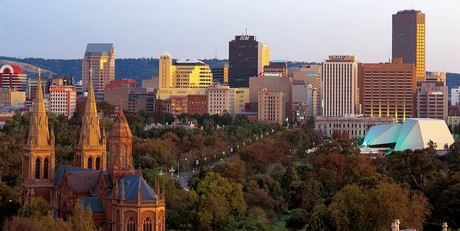The City of Carbon Neutrality

It appears that the City of Churches is looking to pull off a miracle, with Adelaide Lord Mayor Martin Haese speaking at COP21 earlier this month about the goal to make his city carbon neutral by 2025.
The plan was officially announced in April, when the South Australian Government and Adelaide City Council jointly set the ambitious target of achieving carbon neutrality in the next 10 years. Professional services firm pitt&sherry was engaged by the South Australian Government to provide an initial assessment — and later a more detailed strategy paper — outlining the plan.
Emissions reduction has been on the agenda for Adelaide for several years now, with the council reducing carbon emissions generated by its office buildings, car parks, libraries, community centres and Central Market precinct by 60% since 2007. Almost 50% of the cuts in the administration building were achieved through changing the building’s lighting system to energy-efficient LED lights and upgrading old air-conditioning units.
Between 2007 and 2013, the City of Adelaide reduced its carbon emissions by 19%, while gross regional product increased by more than $4 million. According to Haese, this is proof that “the whole argument that you can’t grow your economy without increasing your greenhouse gas emissions has been decoupled”.
This city-wide reduction can be attributed to largely the greening of the electricity supply — including large-scale wind and solar projects, rooftop solar photovoltaics — and further energy-efficiency improvements in new and existing commercial buildings. Not only is South Australia is blessed geographically with easy access to wind and solar resources, but the City of Adelaide is also looking to capitalise on renewable energy storage.
In July this year, the council launched a Sustainable Incentive Scheme offering financial incentives to residents and businesses looking to install solar energy storage batteries. The state government matched the council’s $150,000, bringing the total pool of funds to $300,000.
“It was the first incentive in Australia for energy storage, and we just got bombarded with interest,” the council’s senior sustainability adviser, Adrian Stokes, said.
“We opened up quite the Pandora’s box.”
In addition to this financial incentive, the South Australian Government recently released new measures to stimulate economic growth through the creation of green jobs. These included:
- a new waste strategy to reduce the city’s landfill by diverting 70% of metropolitan household waste by 2020;
- an expression of interest calling on low-carbon energy providers to service 100% of the government’s electricity usage;
- an additional $300,000 funding for three projects, creating new jobs in the state’s waste and recycling sector;
- an ongoing investigation into the opportunities to convert the government’s 4500-strong car fleet to zero-emission vehicles.
According to Haese, the plan could be just what’s needed to improve Adelaide’s ranking as the fifth most livable city in the world.
“I just wonder when we are talking about investment, technology, jobs, the environment, and just as important livability… I think pushing us up that leaderboard and grabbing the status of the world’s first carbon neutral city could be the thing upon which they all converge,” he said.
A concrete use for carpet fibres
Australian engineers have come up with an unexpected use for discarded carpets: as a means to...
COP29: finance, a "crucial" opportunity and a seat at the table
Leaders and diplomats from around the world are descending on Baku, Azerbaijan, this month for...
Spacious, sturdy and relocatable: steel site office ticks all the boxes
When looking for a new office design, green steel company InfraBuild enlisted Modulate — a...









